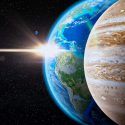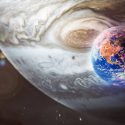A scorching hot never-ending day on one side and a permanent frozen night on the other. This is what our planet would be like if it was tidally locked to the Sun. How would your life be different on this Earth? Where would you actually be able to survive? And what would happen to your sense of time?
Earth makes one full rotation on its axis every 24 hours. And every 365 days, we complete our orbit around the Sun. This is what gives us our sunrises, sunsets and changes of season. If the speed of this rotation and revolution were the same, then Earth would be tidally locked. This means that one side of the planet would always be facing the Sun. And the other would face away, shrouded in perpetual darkness.
This is why you can only see one side of the Moon. It’s tidally locked to the Earth. You should enjoy that nighttime view while you still have it. Depending on what side of the planet you’re on, you could never see the Moon or stars ever again. With one side of the planet facing the wrath of the Sun and the other facing the darkness of space, your best odds for survival would be to live somewhere between the two. Welcome to the twilight zone.
This thin strip of land that borders both day and night is also called the terminator line. It would possibly be the only area on a tidally locked Earth where things are not too hot and not too cold. Just like our Solar System’s Goldilocks zone. The width of this terminator line would likely be exactly the same as it is today, about 60 km (37 mi).
The only difference is that instead of moving across the planet every day as it rotates, this strip would be permanent. If this area of never-ending dusk and dawn were the only place for humans to live, things would be quite crowded. It would mean everyone would squeeze into a space as large as Argentina, or 25% of the U.S. That is, if you got lucky and the entire strip was covered in land and not water.
Whether anywhere outside of this zone is habitable would depend on how well heat could be transported around the planet. If there are strong enough jet winds on each hemisphere, they could move hot air from one side and cold air to the other. With an atmosphere as thick as ours, these winds could take the scorching daytime side down a few notches. And you’d be thankful for every cloud providing some temporary shade from the Sun.
This hemisphere could end up resembling the temperatures of Earth’s current tropical regions. Life would be challenging on our planet. Even with a small temperature between each side, there would be a big pressure difference. That could turn those once-helpful jet winds into super powerful destructive ones. One of the things you’d find hardest to get your hands on would be liquid water.
If you were lucky, there would be areas of the daytime side with a mild enough climate that you could have liquid water. But it may not be enough to sustain everyone. And on the dark side, the water would likely freeze to ice. With such an extreme temperature variation, you could see water molecules going through a vicious cycle.
On the daytime side, the intense heat would lead to evaporation. Then, they could drift over to the dark side, form back into clouds and return to the daytime side, where the process would be repeated all over again. So you’d have to get creative. You could develop some kind of mining and transport operation to take ice from the cold side and melt it.
Or you could convert water vapor from the day side into liquid water. One thing you’d have enough of is solar power. On the sunny side of the planet, your supply would be endless. You’d just have to make sure your solar panels could withstand the intense heat. Solar panels already don’t work properly in some of the hotter places in the world.
Temperatures as high as 50 °C (122 °F), plus a large build-up of dust could make these panels 50% less efficient. But you could use the blazing temperatures themselves as a way to generate electricity. You’d need what’s called thermoelectric technology. By placing one end of the device on the hot side of the planet and the other end on the cold side, you could get free electricity simply from the temperature difference.
There’s a chance this wouldn’t give you much to work with though. That’s because these thermoelectric devices are usually only used for things that don’t demand a ton of power. So you could back up your batteries or keep your minifridge cool. Trying to figure out how and where you could live outside the twilight zone would be tough.
On the hot side, you could be dealing with rocks melting around you. You wouldn’t be able to build a house on a permanent magma ocean. And the cold side would make surface living nearly impossible. Instead, you could live deep underground. There, you’d enjoy the warmth of geothermal heating. Closer to the twilight zone, you could get by in heavily insulated houses.
You’d just need to crank up the air conditioner, electric radiator or geothermal furnace. If you wanted to take more drastic measures to cool down the hot side of the planet, you could try to block out the Sun. And no, I don’t mean with a giant shade. You could borrow a trick from the 1991 volcanic eruption of Mount Pinatubo in the Philippines.
This released so much sulfur dioxide into the stratosphere that it cooled the entire planet down by 0.5 °C (0.9 °F). For global warming, this could be a helpful solution. But it wouldn’t be quite enough to cool down the entire hot side of the planet. You’d also need to come up with some new ways to support plant life.
If they didn’t freeze first, plants wouldn’t be able to perform photosynthesis on Earth’s dark side. On the light side, most plants would be cooked within hours. You’d need to supply them with artificial sunlight. Along the terminator line, you’d be able to harvest a few plants that don’t need much light, like wheatgrass and white asparagus.
Or, you could go the fungus route with different varieties of mushrooms. If all of this weren’t enough already, the sky would never change. You’d need to find a new way to measure hours, days and months. And if you didn’t settle on the dark side of the Earth, you’d never see much of the night sky ever again. No Moon, no stars and no planets to dream about.
A few generations down the line, you could find that humans have forgotten about the rest of the Solar System or Universe entirely. But hey, maybe things could be worse? Instead of spinning very slowly, Earth could be spinning at the speed of light.
Sources
- “Scientists Discover A Planet Where It Rains Rocks And Its Oceans Are Literally Lava”. Stacey Leasca. 2020. travelandleisure.com.
- “What Is Tidal Locking?”. Fraser Cain. 2015. phys.org.
- “There Are Planets So Close To Their Stars That They Have Magma Oceans 100Km Deep And Winds That Go 8000 Km/H”. Matthew Cimone. 2020. universetoday.com.
- “Beyond The Twilight Zone”. Nathaniel Scharping. 2020. knowablemagazine.org.
- “Desert Sun In Qatar Too Hot For Solar Panels To Work”. Emily Gosden. 2022. thetimes.co.uk.



























